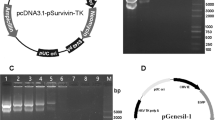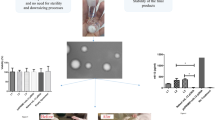Abstract
Suicide gene therapy has been shown to be an effective means of destroying pancreatic cancer cells. Liposomes have been described as having better efficacy in gene delivery, and an advantage of using liposomes as gene carriers is that they can be used repeatedly in vivo. The objective of this study is to compare the effect of gene delivery routes and to determine whether systemic delivery of the rat insulin promoter (RIP)–directed suicide gene construct would permit cell-specific gene delivery in vivo. Severe combined immunodeficient (SCID) mice were injected with liposome-RIP-TK (thymidine kinase) complex by either the intraperitoneal or the intravenous route. Twenty-four hours post gene delivery, mice received ganciclovir (GCV) treatment twice daily for 14 days. Mice were sacrificed at various time points. Complete necropsy and serum chemistry analysis were performed. Islet morphology was determined using hematoxylin and eosin (H&E) staining. Serum glucose and insulin levels were also determined. To determine the toxic effect on pancreatic islet cells, immunostaining of insulin-producing and glucagon-producing cells was carried out at each time point. H&E staining indicated that both intravenous and intraperitoneal liposome-RIP-TK gene expression had no effect in normal endocrine islet cells. Both gene-delivery routes in mice resulted in normal glycemia and serum insulin levels. The endocrine islets were intact, with a normal distribution pattern of insulin-producing beta cells and glucagon-secreting alpha cells. However, serum chemistry analysis revealed significantly elevated levels of liver enzymes; suggesting that possible liver damage had occurred with the intraperitoneal gene delivery of liposome-pRIP-TK. Intravenous liposome-mediated gene delivery had no effect on liver enzyme levels. Liposome-mediated gene delivery via intravenous injection was less toxic than intraperitoneal delivery. This gene-delivery route requires fewer liposome-DNA complexes and maintains normal liver function. Thus, intravenous delivery of gene therapy would be superior to intraperitoneal administration of gene therapy in mice.


Similar content being viewed by others
References
GG Ginsberg (2000) ArticleTitleNew developments in pancreatic cancer, Semin Gastrointest. Dis. 11 162–167 Occurrence Handle1:STN:280:DC%2BD3M%2Fms12gsA%3D%3D
MF Brennan (2000) ArticleTitlePancreatic cancer J. Gastroenterol. Hepatol. 15 G13–G16 Occurrence Handle10.1046/j.1440-1746.2000.02259.x Occurrence Handle11100987
Yeo, CJ, Cameron, JL (1997) In: Sabiston, Dc, Lyerly, Hk (editors), Neoplasms of the Pancreas Exocrine Tumors, 5, W.B. Saunders Company, Philadelphia
K Aoki T Yoshida N Matsumoto et al. (1997) ArticleTitleGene therapy for peritoneal dissemination of pancreatic cancer by liposome-mediated transfer of herpes simplex virus thymidine kinase gene Hum. Gene Ther. 8 1105–1113 Occurrence Handle1:CAS:528:DyaK2sXktVCrtb4%3D Occurrence Handle9189768
H Kanyama N Tomita T Yamono et al. (2001) ArticleTitleUsefulness of repeated direct intratumoral gene transfer using hemagglutinating virus of Japan-liposome method for cytosine deaminase suicide gene therapy Cancer Res. 61 14–18 Occurrence Handle1:CAS:528:DC%2BD3MXlsl2ntg%3D%3D Occurrence Handle11196152
RM Schmid H Weidenbach H Yamagushi et al. (1998) ArticleTitleDirect gene transfer into the rat pancreas using DNA-liposomes Eur. J. Clin. Invest. 28 220–226 Occurrence Handle10.1046/j.1365-2362.1998.00269.x Occurrence Handle1:CAS:528:DyaK1cXisFOrurs%3D Occurrence Handle9568468
NS Templeton DD Lasic PM Frederik et al. (1997) ArticleTitleImproved DNA: liposome complexes for increased systemic delivery and gene expression Nat. Biotech. 15 647–652 Occurrence Handle10.1038/nbt0797-647 Occurrence Handle1:CAS:528:DyaK2sXktlOgsL0%3D
Y Zhang H Lu P Li Wang et al. (2003) ArticleTitleOptimization of gene expression in nonactivated circulating lymphocytes Mol. Ther. 8 629–636 Occurrence Handle10.1016/S1525-0016(03)00231-4 Occurrence Handle1:CAS:528:DC%2BD3sXns1Kqs7s%3D Occurrence Handle14529836
R Ramesh T Saeke NS Templeton et al. (2001) ArticleTitleSuccessful treatment of primary and disseminated human lung cancers by systemic delivery of tumor suppressor genes using an improved liposome vector Mol. Ther. 3 337–350 Occurrence Handle10.1006/mthe.2001.0266 Occurrence Handle1:CAS:528:DC%2BD38XitVGrs7g%3D Occurrence Handle11273776
TA Tirone SP Fagan NS Templeton et al. (2001) ArticleTitleInsulinoma-induced hypoglycemic death in mice is prevented with beta cell-specific gene therapy Ann. Surg. 233 603–611 Occurrence Handle10.1097/00000658-200105000-00002 Occurrence Handle1:STN:280:DC%2BD3MzisFKksw%3D%3D Occurrence Handle11323498
Tirone TA, Wang XP, Templeton NS, et al. Cell-specific cytotoxicity of human pancreatic adenocarcinoma cells using rat insulin promoter thymidine kinase directed gene therapy. World. J. Surg. 2004; 28: 826–833
FD Ledley (1993) ArticleTitleHepatic gene therapy: present and future Hepatology 18 1263–1273 Occurrence Handle10.1016/0270-9139(93)90486-7 Occurrence Handle1:STN:280:ByuD2c7itFE%3D Occurrence Handle8225234
L Blaszkowsky (1998) ArticleTitleTreatment of advanced and metastatic pancreatic cancer Front. Biosci. 3 214–225
P McMahon E Halpern C Fernandez-del Castillo et al. (2001) ArticleTitlePancreatic cancer: cost-effectiveness of imaging technologies for assessing resectability Radiology 221 93–106 Occurrence Handle1:STN:280:DC%2BD3Mrit1KjsQ%3D%3D Occurrence Handle11568326
N Zhu D Liggitt Y Liu et al. (1993) ArticleTitleSystemic gene expression after intravenous DNA delivery into adult mice Science 261 209–211 Occurrence Handle1:CAS:528:DyaK3sXkvVOmtbc%3D Occurrence Handle7687073
Y Liu D Liggitt InstitutionalAuthorNameZhong (1995) ArticleTitleCationic liposome-mediated intravenous gene delivery J. Biol. Chem. 270 24864–24870 Occurrence Handle10.1074/jbc.270.42.24864 Occurrence Handle1:CAS:528:DyaK2MXovFWms7w%3D Occurrence Handle7559609
SW Dow RE Elmslie AP Willson et al. (1998) ArticleTitleIn vivo tumor transfection with superantigen plus cytokine genes induces tumor regression and prolongs survival in dogs with malignant melanoma J. Clin. Invest. 101 2406–2414 Occurrence Handle1:CAS:528:DyaK1cXjvVWrurY%3D Occurrence Handle9616212
WM Siders K Vergillis C Johnson et al. (2002) ArticleTitleTumor treatment with complexes of cationic lipid and noncoding plasmid DNA results in the induction of cytotoxic T cells and systemic tumor elimination Mol. Then 6 519–527 Occurrence Handle1:CAS:528:DC%2BD38Xns1KlurY%3D
L Mohr SK Yoon SJ Eastman et al. (2001) ArticleTitleCationic liposome-mediated gene delivery to the liver and to hepatocellular carcinomas in mice Hum Gene Ther. 12 799–809 Occurrence Handle1:CAS:528:DC%2BD3MXjsVegt7o%3D Occurrence Handle11339896
P Bankey E Beecherl E Bibus et al. (1995) ArticleTitleLiposomes modulate Kupffer cell endotoxin response Arch. Surg. 130 1266–1272 Occurrence Handle1:CAS:528:DyaK28XmvFWmsA%3D%3D Occurrence Handle7492273
M Shichiri A Tanaka Y Hirata (2003) ArticleTitleIntravenous gene therapy for familial hypercholesterolemia using ligand-facilitated transfer of liposome:LDL receptor gene complexes Gene Ther. 10 827–831 Occurrence Handle1:CAS:528:DC%2BD3sXivFGqt7g%3D Occurrence Handle12704424
J Norman W Denham D Denham et al. (2000) ArticleTitleLiposome-mediated, nonviral gene transfer induces a systemic inflammatory response which can exacerbate pre-existing inflammation Gene Ther. 7 1425–1430 Occurrence Handle1:CAS:528:DC%2BD3cXlvFajsL8%3D Occurrence Handle10981671
Acknowledgements
This project is supported in part by an Advances in Technology Transfer Grant (ATP1176) from the State of Texas Department of Education and NIH R01 grant (CA95731), both to Dr. F. C. Brunicardi. We thank our colleagues working in Dr. Brunicardi’s laboratory for their assistance and support. Thanks also go to Dr. C. Brayton for pathologic examination and technique guidance throughout the project. Gratitude is also extended to Ms. Katie Elsbury for her editorial assistance.
Author information
Authors and Affiliations
Corresponding author
Rights and permissions
About this article
Cite this article
Wang, X.P., Yazawa, K., Templeton, N.S. et al. Intravenous Delivery of Liposome-mediated Nonviral DNA Is Less Toxic than Intraperitoneal Delivery in Mice. World J. Surg. 29, 339–343 (2005). https://doi.org/10.1007/s00268-004-7822-5
Published:
Issue Date:
DOI: https://doi.org/10.1007/s00268-004-7822-5




